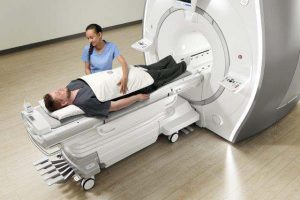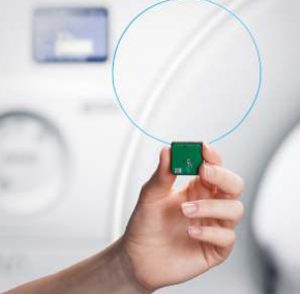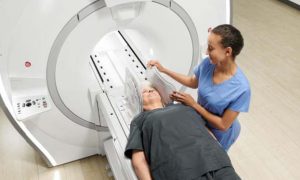The new coil design is 60 percent lighter than conventional coils and conforms to a variety of patient sizes in fact, the 48-channel head coil is designed to fit 99.9 percent of patients. It is truly making MR a personalized experience for the patient
An MRI consists of multiple coils of conductive wire stacked and loop around the core of the coil. Each wire serves a different purpose, but are usually a physically small antennae of sorts. They produce a uniform magnetic field without producing significant amounts of radiation. There are many types available that includes Gradient, RF, Surface, Volume, Shim, Array and Extremity.
The most commonly type of coils that are used in the MRI industry is RF (Radiofrequency) coils that are used as transmitters and receivers of RF signals in equipment used in MRI.
The RF frequency electromagnetic field produced as transmitters is a magnetic near-field with very little associated changing electric field component (such as all conventional radio wave transmissions have). Thus, the high-powered electromagnetic field produced in the MRI transmitter coil does not produce much electromagnetic radiation at its RF frequency, and the RF power is confined to the coil space and not radiated as ‘radio waves’. Thus, the transmitting coil is a good EM near-field generator at radio frequency, but a poor EM radiation transmitter at radio frequency.
 The receiver coil picks up the oscillations at RF frequencies produced by precession of the magnetic moment of nuclei inside the subject. The signal acquired by the coil is thus an induced emf, and is not the result of picking up radio waves.
The receiver coil picks up the oscillations at RF frequencies produced by precession of the magnetic moment of nuclei inside the subject. The signal acquired by the coil is thus an induced emf, and is not the result of picking up radio waves.
The inductor market is expected to grow from $3.01 billion in 2015 to $3.94 billion by 2022, at a CAGR of 3.93% between 2016 and 2022, according to marketsandmarkets.com.
GE’s latest AIR Technology is an industry-leading coil suite designed to truly conform to the human body. It was inspired by the desire to challenge the longtime limitations of traditional rigid coils.
By mimicking universal experiences that bring us all comfort and security, the AIR Technology™ coil suite is both comforting and comfortable. Each coil is lightweight, flexible and just like a blanket, they closely wrap around your patient for incredible image quality.
 Mr. Tamer Khalaf, Marketing & Applications Director for MR at GE Healthcare in the Eastern Growth Markets tells Ayesha Rashid of Mediworldme how AIR Technology enables total freedom in coil positioning and handling during MRI scans?
Mr. Tamer Khalaf, Marketing & Applications Director for MR at GE Healthcare in the Eastern Growth Markets tells Ayesha Rashid of Mediworldme how AIR Technology enables total freedom in coil positioning and handling during MRI scans?
Tell us in detail about you AIR technology?
AIR Technology is an industry-first suite of RF coils enabling total freedom in coil positioning and handling during MRI scans. They are designed to conform to the human body just like a comfortable blanket. AIR Coils use innovative conductor material designed for ultra- flexibility, so it can be closely wrapped around patients for incredible image quality. AIR Touch automates coil selection with one touch leading to up to 59 % improvement in patient setup time, and 37% reduction in scan time.
 How does AIR technology deliver a simply better experience with versality and productively?
How does AIR technology deliver a simply better experience with versality and productively?
The innovative design of AIR Technology, including AIR Touch, allows for high consistency and repeatability between MR technologists and improves productivity by reducing patient setup and scan times.
The coil can be adapted to the patient rather than the patient adapting to the coil. With the help of AIR coils and AIR Touch, complex scans like elbows and shoulders are now easier and more consistent for the techs to position and more comfortable for the patient.
The innovative conductor material was designed to allow more coil elements in the Field of View (FOV i.e. area we are trying to scan). This improves signal reception (also called SNR), depth of penetration speed, and image quality.
Major difference between A I R and traditional coils?
AIR coils are made of entirely new innovative conductor material designed to greatly reduce a common limitation with conventional coils called coupling. When coil elements overlap each other, signal is greatly reduced because of coupling. This is especially common in traditional ‘flexible’ coils when trying to image hips, shoulders, and legs where the coil must wrap around the body. Reducing this coupling phenomenon with AIR coils also allows us to put more coil elements in the FOV leading to higher SNR.
AIR Coils are lighter weight, more comfortable and flexible offering a better technologist and patient experience.
Patients, technologists and radiologists all enjoy benefits from AIR Coils.
How does it reduce patient stress and offer a more conclusive body scan?
Patient stress and anxiety is generally related to one of two things: staying for extended periods of time inside the magnet bore and having heavy ‘cage-like’ and ‘intimidating’ coils placed on them.
AIR coils greatly improve SNR, which can lead to higher acceleration factors for faster scans. If we can scan these patients and get them out of the magnet bore faster, it will greatly reduce stress and anxiety. Furthermore, because AIR coils are light weight and flexible, they can be inconspicuous.
What made you come up with a sophisticated technology like AIR?
Our team has always delivered transformational technology starting with the first commercial high-field 1.5T SIGNA MRI system in 1983. In coil technology, it started with the introduction of phased arrays in 1991. Today, phased array technology is the foundation of all MR coils in the industry. The introduction of AIR Technology is simply the continuation of a long and rich histor y of innovation to make MR scans more comfortable for both the user and the patient.
 What is your vision behind AIR technology?
What is your vision behind AIR technology?
Our vision in MR is to provide results that are fast, consistent, quantifiable and personalized; AIR technology delivers on multiple facets of that vision.
Recent advancements in MRI industry?
Patient experience and comfort has been an ongoing trend in MRI. GE has led the way in this front by being the first to introduce Silent Scan (sound is a major source of discomfort for patients), AIR coils, and perfecting wide bore magnets. Sohware and potential of AI has also opened new frontiers for MRI. GE already has 6 different AI- based applications, and more are coming as a result of work with our global and regional collaborators.
How will AIR transform patient experience?
The new coil design is 60 percent lighter than conventional coils and conforms to a variety of patient sizes – in fact, the 48-channel head coil is designed to fit 99.9 percent of patients. It is truly making MR a personalized experience for the patient.
Technology used to deliver AIR?
It took two separate and simultaneous research projects todevelop the innovative components behind AIR Coils. GE’s proprietary E-mode electronics reduce current noise, boost linearity and improve tolerance to varying coil loading conditions. It makes the most out of every centimeter to reduce component volume by more than 60 percent. The conductor material for the loop is lightweight and bendable and a series of linked resonators replaces the rigid circuit boards and lumped components that comprise conventional coils.
These two technologies work very closely together to get high SNR with minimal interaction between the two elements.
Describe the development process of AIR?
GE Healthcare’s Coils team, inspired by the blanket we useto cover patients during MR scans, had a vision to make MR coils lightweight and ultra-flexible just like a blanket. Their philosophy during the development was to never compromise. From the start this was the design team’s philosophy. And every time they found themselves starting to compromise, they started over.
Is AIR one of the advancements in MRI industry?
The industry itself is recognizing this as a breakthrough. AIR Coil Technology was named Aunt Minnie Best New Radiology Device for 2019. AIR technology is exclusive to the MRI environment and currently does not lend itself well to other industries.
What does the future hold for AIR in the MRI industry?
The President & CEO of our Global MR business, Eric Stahre, says, “we are only limited by our imagination and our customers’ imagination to come up with new and different designs.” I couldn’t agree more. In the same way the introduction of phased arrays in 1991 transformed MR coil technology, we believe that AIR technology will set the new standard.











